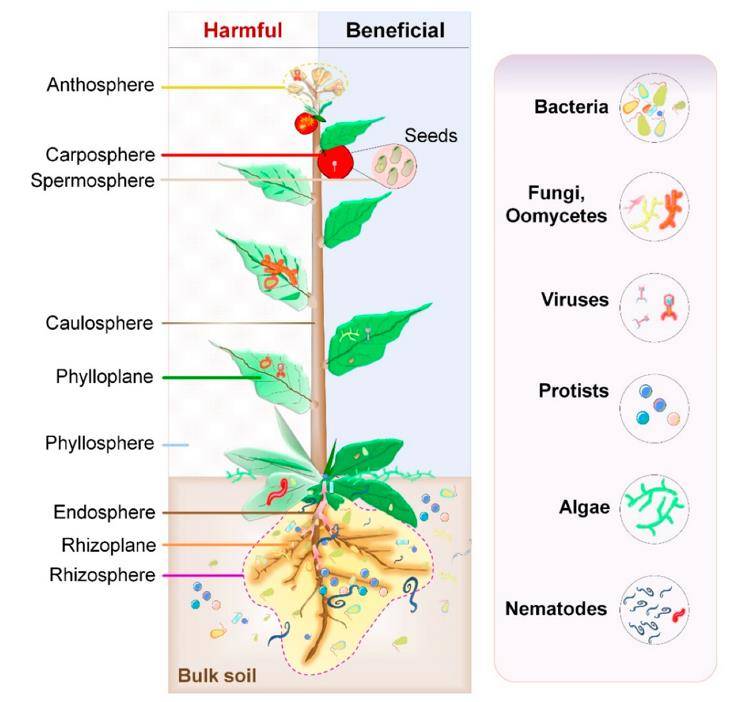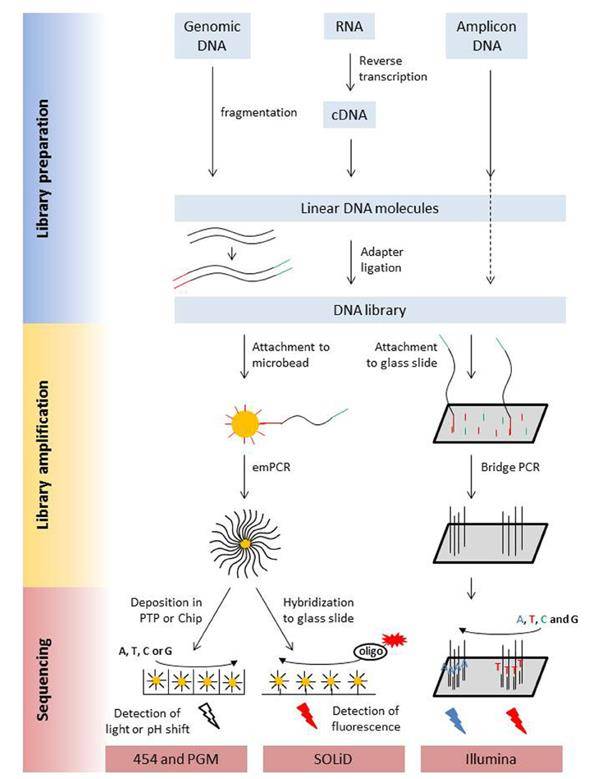What is the microbiome?
The microbiome refers to a collection of microorganisms possessing distinct physicochemical characteristics, occupying well-defined and reasonable habitats. This term encompasses not only the microorganisms themselves but also their active zones, which establish specific ecological niches. This dynamic and interactive microecosystem undergoes changes over time and scale and holds crucial importance for the functioning and health of its host. Comprising microorganisms from various domains such as prokaryotes (bacteria, archaea) and eukaryotes (protozoa, fungi, algae), the microbiome's 'active zone' includes microbial structures, metabolites, mobile genetic elements (such as transposons, phages, and viruses), as well as residual DNA embedded within the habitat's environment.
The Microbiome's Role in Plants
Microbial communities within plants exhibit marked differences in terms of their composition compared to those in animals. Due to the greater abundance and diversity of plant communities, the microorganisms found in plants are relatively more intricate. These plant microorganisms can be categorized into surface microorganisms and intra-tissue microorganisms based on their colonization sites.
Plants are firmly rooted in the soil, and their root system, along with its apoptosis, abscission, and secretions, serves as a vital source of nutrients and energy for microorganisms. The root system's intricate structure also results in improved water status and aeration conditions within the approximately 1 mm thickness close to the root, forming what is known as the inter-root region. This inter-root region stands as the primary site for nutrient and information exchange between plants and soil, harboring microorganisms known as inter-root microorganisms.
Some microorganisms manage to overcome the host's barriers and enter the root, becoming intra-root microorganisms. Additionally, microorganisms residing on the leaf's surface, particularly around stomata, are called interleaf microorganisms. Those capable of penetrating stomata or other barriers to infiltrate plant tissues are known as intraleaf microorganisms. Notably, the microorganisms recruited from diverse species or even different tissue parts of the same species exhibit distinct profiles, though certain patterns emerge. Bacterial populations are primarily dominated by groups like Ascomycetes, Anaplasma, Posterobacteria, and Actinobacteria, while fungi are mainly represented by Ascomycetes and Stamenomycetes.
 Microbiome in plant ecosystem. (Shelake et al., 2019)
Microbiome in plant ecosystem. (Shelake et al., 2019)
What factors influence the structure of plant microorganisms?
The structure of the plant microbiome is shaped by a multitude of factors. The physical and chemical attributes of the soil act as the initial determinant, influencing the scope of the community that plant roots can directly engage with. Environmental fluctuations, insect activity, and herbivorous feeding exert a significant influence on the microbial assembly accessible to the above-ground parts of the plant. The specific plant species and its growth phase play a direct role in selecting the microbiome associated with the plant. These dynamics collectively impact the lateral dispersion of the plant microbiome. In the case of flowering plants, microorganisms also hitch a ride through pollen, nectar, and eventually seeds, transmitting vertically as seed microorganisms to the subsequent life cycle.
Simultaneously, plants actively assess environmental microbes based on specific requirements. Initially, primary compounds generated through photosynthesis, like sugars and amino acids, are secreted into the surrounding milieu via the roots. This prompts recruitment of microorganisms from the soil's microbial seed bank, facilitated by nutrient provisions. Furthermore, secondary metabolites such as coumarins, phenolic compounds, and post compounds are synthesized, prompting a screening process for appropriate microbial partners. Some partners seek to establish a closer rapport and infiltrate tissues via cortical cells. The plant exercises a more meticulous screening here, activating its own immune responses to expel unwelcome partners. Ultimately, diverse levels of cooperation are established with microorganisms that fulfill distinct functions, contingent on the plant's requirements."
Advancing Plant-Microbiome Research through Sequencing Technology
Taking this investigative path to a heightened level, metatranscriptomics delves deeper by targeting the RNA molecules within a sample. This method provides a real-time perspective on the active gene expression dynamics of the microbial community, thereby furnishing an intricate portrayal of their functional roles in a dynamic context. Through rigorous analysis of the transcriptome in the context of the plant microbiome, researchers can adeptly pinpoint the genetic underpinnings of varied activities encompassing nutrient cycling, defense mechanisms against pathogens, and intricate communication channels established with the plant host.
Please read our article Overview of Metatranscriptomic Sequencing: Principles, Workflow, and Applications.
- 16S rRNA and ITS Sequencing
At the forefront of microbiome analysis lies the pivotal technique of sequencing specific gene regions inherent to microbial genomes, such as the 16S ribosomal RNA gene for bacterial entities and the Internal Transcribed Spacer (ITS) region for fungal counterparts. These genes exhibit remarkable conservation across species while simultaneously housing variable domains that facilitate discrimination between diverse microbial taxa. By harnessing the power of 16S rRNA and ITS sequencing, researchers are adeptly equipped to derive a meticulous taxonomic profile of the microbiome, thereby unearthing intricate patterns of diversity and the relative prevalence of assorted microbial cohorts.
For more information, please refer to Principles and Workflow of 16S/18S/ITS Amplicon Sequencing.
A distinctive pursuit within this investigative landscape is the paradigm of shotgun metagenomics, characterized by an all-encompassing sequencing of genetic material within a sample, sans the constraint of gene-specific targeting. This holistic strategy furnishes an all-encompassing depiction of the genetic potential encapsulated within the microbial community, allowing for an in-depth exploration of not merely the taxonomic dimensions, but also the functional proficiencies exhibited by these microorganisms. Insights garnered through shotgun metagenomics extend beyond taxonomic identification, into realms encompassing gene content, metabolic pathways, and the potential interplays within the intricate microbiome.
You may be interested in our article Introduction to Shotgun Metagenomics, from Sampling to Data Analysis.
 The library preparation and sequencing process of next generation sequencing platforms. (Knief et al., 2014)
The library preparation and sequencing process of next generation sequencing platforms. (Knief et al., 2014)
The advent of long-read sequencing technologies, exemplified by platforms like Pacific Biosciences (PacBio) and Oxford Nanopore, has bestowed researchers with an unparalleled capacity to generate extended DNA sequences in a singular reading event. This technological stride is especially germane in the assembly of intricate microbial genomes and the resolution of genomic discrepancies that emerge within species. The potential of long-read sequencing extends to the discovery of hitherto uncharted microbial species and sub-strains nestled within the plant microbiome, thereby illuminating dimensions of diversity that had hitherto eluded scrutiny.
- Bioinformatics Challenges and Solutions
In tandem with these transformative methodologies, it becomes evident that the generation of copious data sets poses formidable challenges in the realms of data analysis and interpretation. The pivotal role of bioinformatics tools becomes pronounced in the context of processing, dissecting, and visually representing the intricate data landscapes that emerge. Researchers are equipped with an assortment of algorithms and data processing pipelines, each dedicated to tasks such as taxonomic assignment of sequences, prognostication of functional genes, and the meticulous reconstruction of microbial genomes from fragmented data sources. This dynamic landscape is further enriched through the evolution of machine learning paradigms and the confluence of data integration strategies, both of which empower researchers in deciphering the intricate tapestry of relationships embedded within the plant microbiome.
The Role of Symbiotic Microorganisms in Plant
(i) Symbiotic microorganisms contribute nutrients to the host.
Microorganisms that live symbiotically in plant roots enhance nutrient uptake. Notably, certain bacteria, like nitrogen-fixing, ammonifying, and nitrifying types, facilitate the transfer of nitrogen from the environment to the plant. Additionally, clumping fungi aid the plant's growth by converting mineral nutrients into an accessible form through oxidation and solubilization.
(ii) Symbiotic microorganisms alter plant growth characteristics.
The presence of symbiotic microorganisms can modify the physical attributes of plants. Recent research has highlighted how bacteria colonizing plant roots can reshape the morphology of roots. This is achieved by activating the ethylene response pathway, directly influencing characteristics such as root length and diameter, as well as the diameter, volume, and density of lateral roots in Arabidopsis thaliana.
(iii) Symbiotic microorganisms enhance host resistance against pathogens.
During pathogen attacks, specialized root or leaf symbiotic communities are recruited through a "call for help" strategy. These communities assist in thwarting pathogen invasions by leveraging bacterial antagonism and triggering immune responses within the host plant.
(iv) Plant-microbiome Interaction: Synergistic Responses Encompassing Entire Functional Spectrum.
Mutually beneficial selection processes between plants and their associated communities lead to the development of a more integrated response mechanism to environmental changes. This synergy forms a cohesive "functional unity" that adapts in tandem. In the context of varietal diversity, indica rice is capable of enlisting distinct communities to enhance nitrogen uptake. Furthermore, symbiotic communities significantly influence the disease resistance development of hybrid rice.
References:
-
Shelake, Rahul Mahadev, Dibyajyoti Pramanik, and Jae-Yean Kim. "Exploration of plant-microbe interactions for sustainable agriculture in CRISPR era." Microorganisms 7.8 (2019): 269.
- Knief, Claudia. "Analysis of plant microbe interactions in the era of next generation sequencing technologies." Frontiers in plant science 5 (2014): 216.
For research purposes only, not intended for clinical diagnosis, treatment, or individual health assessments.


 Sample Submission Guidelines
Sample Submission Guidelines
 Microbiome in plant ecosystem. (Shelake et al., 2019)
Microbiome in plant ecosystem. (Shelake et al., 2019) The library preparation and sequencing process of next generation sequencing platforms. (Knief et al., 2014)
The library preparation and sequencing process of next generation sequencing platforms. (Knief et al., 2014)